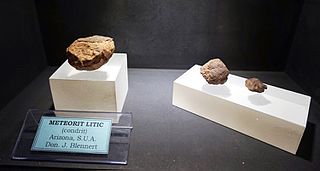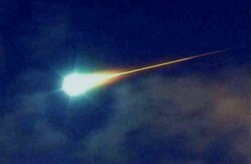Related Research Articles

A meteorite is a rock that originated in outer space and has fallen to the surface of a planet or moon. When the original object enters the atmosphere, various factors such as friction, pressure, and chemical interactions with the atmospheric gases cause it to heat up and radiate energy. It then becomes a meteor and forms a fireball, also known as a shooting star; astronomers call the brightest examples "bolides". Once it settles on the larger body's surface, the meteor becomes a meteorite. Meteorites vary greatly in size. For geologists, a bolide is a meteorite large enough to create an impact crater.

In meteoritics, a meteorite classification system attempts to group similar meteorites and allows scientists to communicate with a standardized terminology when discussing them. Meteorites are classified according to a variety of characteristics, especially mineralogical, petrological, chemical, and isotopic properties.

The Field Museum of Natural History (FMNH), also known as The Field Museum, is a natural history museum in Chicago, Illinois, and is one of the largest such museums in the world. The museum is popular for the size and quality of its educational and scientific programs, and its extensive scientific specimen and artifact collections. The permanent exhibitions, which attract up to 2 million visitors annually, include fossils, current cultures from around the world, and interactive programming demonstrating today's urgent conservation needs. The museum is named in honor of its first major benefactor, Marshall Field, the department-store magnate. The museum and its collections originated from the 1893 World's Columbian Exposition and the artifacts displayed at the fair.

The University of Santo Tomas Manila, officially the Pontifical and Royal University of Santo Tomas, Manila or colloquially as Ustê, is a private, Catholic research university in Manila, Philippines. Founded on April 28, 1611, by Spanish friar Miguel de Benavides, third Archbishop of Manila, it has the oldest extant university charter in Asia and is one of the world's largest Catholic universities in terms of enrollment found on one campus. It is the main campus of the University of Santo Tomas System that is run by the Order of Preachers.

The Willamette Meteorite, officially named Willamette and originally known as Tomanowos by the Clackamas Chinook Native American tribe, is an iron-nickel meteorite found in the U.S. state of Oregon. It is the largest meteorite found in the United States and the sixth largest in the world. There was no impact crater at the discovery site; researchers believe the meteorite landed in what is now Canada or Montana, and was transported as a glacial erratic to the Willamette Valley during the Missoula Floods at the end of the last Ice Age. It has long been held sacred by indigenous peoples of the Willamette Valley, including the federally recognized Confederated Tribes of the Grand Ronde Community of Oregon (CTGRC).

The Cape York meteorite, also known as the Innaanganeq meteorite, is one of the largest known iron meteorites, classified as a medium octahedrite in chemical group IIIAB. In addition to many small fragments, at least eight large fragments with a total mass of 58 tonnes have been recovered, the largest weighing 31 tonnes. The meteorite is named after the location where the largest fragment was found: 23 miles (37 km) east of Cape York, in Savissivik, Meteorite Island, Greenland.

The pallasites are a class of stony–iron meteorite. They are relatively rare, and can be distinguished by the presence of large olivine crystal inclusions in the ferro-nickel matrix.

The Leicester Museum & Art Gallery is a museum on New Walk in Leicester, England, not far from the city centre. It opened in 1849 as one of the first public museums in the United Kingdom. Leicester Museum & Art Gallery contains displays of science, history and art, both international and local. The original building was designed by Joseph Hansom, designer of the hansom cab. It has been expanded several times, most recently in 2011.

Iron meteorites, also called siderites or ferrous meteorites, are a type of meteorite that consist overwhelmingly of an iron–nickel alloy known as meteoric iron that usually consists of two mineral phases: kamacite and taenite. Most iron meteorites originate from cores of planetesimals, with the exception of the IIE iron meteorite group.

The Hoba meteorite is named after the farm Hoba West, where it lies, not far from Grootfontein, in the Otjozondjupa Region of Namibia. It has been uncovered, but because of its large mass, has never been moved from where it fell. The main mass is estimated at more than 60 tonnes. It is the largest known intact meteorite and about twice as massive as the largest fragment of either the Cape York meteorite's 31-tonne Ahnighito kept in the American Museum of Natural History or the Campo del Cielo's 31-tonne Gancedo in Argentina. It is also the most massive naturally occurring piece of iron known on Earth's surface. The name Hoba comes from a Khoekhoegowab word meaning 'gift'. Following its donation to the government in 1987, a visitor centre was constructed with a circular stone access and seating area.

A meteorite fall, also called an observed fall, is a meteorite collected after its fall from outer space was observed by people or automated devices. Any other meteorite is called a "find". There are more than 1,300 documented falls listed in widely used databases, most of which have specimens in modern collections. As of February 2023, the Meteoritical Bulletin Database had 1372 confirmed falls.
KMJ is a commercial AM radio station in Fresno, California. It airs a news/talk radio format, and simulcasts with sister station KMJ-FM. Owned by Cumulus Media, the studios and offices are located at the Radio City building on Shaw Avenue in North Fresno.

The Peekskill meteorite is the object resulting from a well-documented meteorite event that occurred in October, 1992, in Peekskill, New York, United States. Sixteen separate video recordings document the meteorite burning through the Earth's atmosphere, whereupon it struck a parked car in Peekskill. The Peekskill meteorite is an H6 monomict breccia; its filigreed texture is the result of the shocking and heating following the impact of two asteroids in outer space. The meteorite is of the stony variety, and approximately 20% of its mass is tiny flakes of nickel-iron. When it struck Earth, the meteorite weighed 27.7 pounds (12.6 kg) and measured one foot in diameter. The Peekskill meteorite is estimated to be 4.4 billion years old.

Park Forest is an L5 chondrite meteorite that fell on 26 March 2003 in Illinois, United States.

The Rice Northwest Museum of Rocks and Minerals is a non-profit museum in Hillsboro, Oregon, United States. Located just north of the Sunset Highway on the northern edge of Hillsboro, the earth science museum is in the Portland metropolitan area. Opened in 1997, the museum's collections date to the 1930s with the museum housed in a home built to display the rock and mineral collections of the museum founders. The ranch-style home is listed on the National Register of Historic Places, the first of its kind listed in Oregon. In 2015 the museum became a Smithsonian Affiliate museum.
Chambord is an iron meteorite found in Quebec.

Hraschina is the official name of an iron meteorite that fell in 1751 near the village of Hrašćina in Hrvatsko Zagorje, Croatia. This meteorite is important because it was the first fall of an iron meteorite viewed and reported by a significant number of witnesses, despite its low remaining total known weight. The Hraschina meteorite also proved that rocks really can "fall from the skies".

Rabiya Occeña Mateo is a Filipino model, host, actress, entrepreneur and beauty pageant titleholder who was crowned Miss Universe Philippines 2020. She represented the Philippines at the Miss Universe 2020 pageant and finished as a top 21 semifinalist.

The Maine Mineral and Gem Museum (MMGM) is a geology museum located in Bethel, Maine. It displays a collection of rocks, minerals, and meteorites.
KMJS Gabi ng Lagim is an annual Halloween television special of GMA Network's news magazine show Kapuso Mo, Jessica Soho, featuring urban legends, horror, and supernatural stories from around the Philippines. It first aired on October 27, 2013, and has since been present annually, usually on the Sunday closest to Halloween and All Saints' Day, also known in the Philippines as Undás.
References
- ↑ "Orconuma meteorite, ibinigay na sa pangangalaga ng National Museum". National Museum. July 12, 2022. Retrieved March 8, 2024.
- ↑ "KMJS has the backstory on the Orconuma Meteorite recently added to the National Museum's geological collection". GMA News Online. July 14, 2022. Retrieved March 7, 2024.
- 1 2 "Slice of Life: Philippine museum displays piece of rare Orconuma meteorite". Explained PH. October 12, 2022. Retrieved March 7, 2024.
- ↑ "KMJS has the backstory on the Orconuma Meteorite recently added to the National Museum's geological collection". GMA News. July 14, 2022. Retrieved September 5, 2024.
- ↑ "National Museum adds Orconuma meteorite to geological collection". GMA News. July 11, 2022. Retrieved September 5, 2024.
- ↑ "Meteoritical Bulletin Database". Meteorological society. Retrieved March 8, 2024.